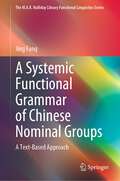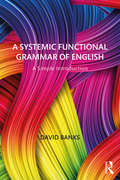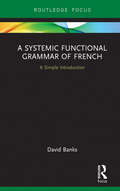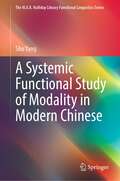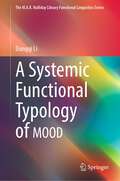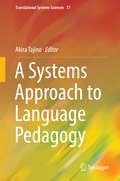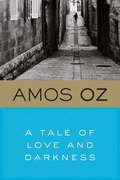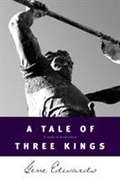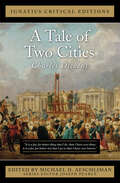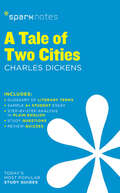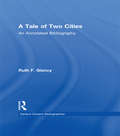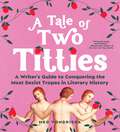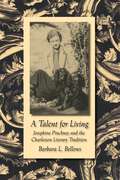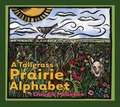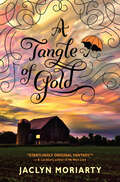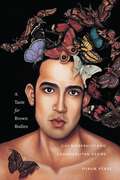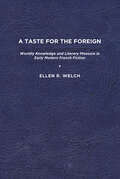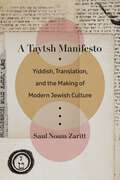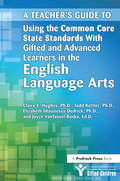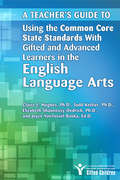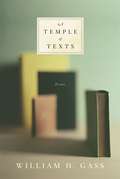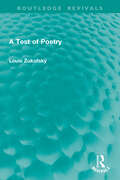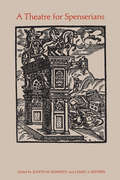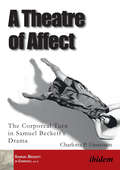- Table View
- List View
A Systemic Functional Grammar of Chinese Nominal Groups: A Text-Based Approach (The M.A.K. Halliday Library Functional Linguistics Series)
by Jing FangThis book describes the grammar of Chinese nominal groups for the purpose of text analysis, drawing upon Halliday’s systemic functional linguistics (SFL) model. Exploring the metafunctional grammatical resources in nominal groups, the book provides a new perspective on conducting text analysis by focusing on the metafunctions performed by various elements in the nominal group. The observations on nominal groups presented here are based on both a working corpus of 180 texts of various types and a large referential corpus of over 16 billion tokens. With clear descriptions of the terminology used, the book presents a case study at the end of each major chapter, which demonstrates how the grammatical resources discussed can be applied to the delicate analysis of authentic texts. This monograph is more than a grammar book, for it offers a new way to engage with a text microscopically and enables readers to approach and analyse a text by focusing on grammatical units below the clause level. The book provides an accessible and valuable resource for readers who are interested in SFL-based typological description, text analysis, translation studies between English and Chinese, English–Chinese comparative linguistic studies, and Chinese language teaching and learning.
A Systemic Functional Grammar of English: A Simple Introduction
by David BanksProviding a simple – but not simplistic – introduction to the Systemic Functional Grammar (SFG) of English, this book serves as a launching pad for the beginning student and a review for the more seasoned linguist. <p><p>With an introduction to SFG through lexicogrammar and the concept of rankshift, this book is the first introduction to SFG (including Appraisal) with examples exclusively sourced from twenty-first century texts. <p><P>Written for those learning English and English linguistics as a foreign language, this serves as an easy-to-read introduction or refresher course for Systemic Functional Linguistics.
A Systemic Functional Grammar of French: A Simple Introduction
by David BanksA Systemic Functional Grammar of French provides an accessible introduction to systemic functional linguistics through French. This concise introduction to the systemic functional grammar (SFG) framework provides illustrations throughout that highlight how the framework can be used to analyse authentic language texts. This will be of interest to students in alternative linguistic frameworks who wish to acquire a basic understanding of SFG as well as academics in related areas, such as literary and cultural studies, interested in seeing how SFG can be applied to their fields.
A Systemic Functional Study of Modality in Modern Chinese (The M.A.K. Halliday Library Functional Linguistics Series)
by Shu YangThis book presents a systematic and relatively comprehensive account of the system of MODALITY in Modern Chinese and the functions that realizations of modality serve in the clause and clause complex. Grounded in SFL, the research begins by introducing the system of types of modality in Modern Chinese, investigating the subtypes of modality and their realizations. The study then explores the systems of Orientations that characterize the realization of modalization and modulation in Chinese. After establishing the complete system of modality in Modern Chinese, the research finally examines the functions that realizations of modality serve in the textual structure of the clause and in the clause complex. The study finds that the system of MODALITY is an important interpersonal clause system at the lexicogrammatical stratum of Chinese. There are two distinct types of modality in Chinese: modalization and modulation. Modalization concerns the assessment of probability of the proposition; modulation is concerned with the assessment of the proposal in terms of obligation, inclination, and ability. The systems of ORIENTATIONS make a basic distinction between subjective and objective modality, and between the explicit and implicit realizations. The research also reveals that in the thematic structure of the clause, realizations of modality can serve as the interpersonal Theme in the clause, in the information structure of the clause, realizations of modality can function as the unmarked information focus of the clause or introduce the marked information focus, and in the clause complex, realizations of modality can encode modal meanings and simultaneously construct clauses into a clause complex.
A Systemic Functional Typology of MOOD (The M.A.K. Halliday Library Functional Linguistics Series)
by Dongqi LiThe grammatical category of (sentence) mood has been of central interest to many branches of linguistics, including linguistic typology and systemic functional linguistics. This book is a successful integration of the typological and systemic functional approaches to mood, aiming to investigate the commonalities and variations across languages in both mood system and mood structure. To this aim, it establishes a geographically, genetically and typologically representative sample of 60 languages and provides detailed systemic functional descriptions of the mood system and mood structure of these languages. Based on such descriptions, it makes cross-linguistic comparisons of the mood system and mood structure of the languages in the sample. Structurally, it explores the cross-linguistic commonalities and variations in (i) the realizations of some major functional elements in mood structure, (ii) the realizations of mood options and (iii) the realizations of mood system. Systemically, it investigates how languages resemble and vary from each other in (i) the subtypes of major mood types, (ii) the organization of mood system and (iii) the semantic dimensions along which mood system is elaborated further in delicacy. Moreover, building on the descriptions and comparisons, it makes some generalizations about the structural and systemic features of mood and proposes some tentative explanations for the commonalities and variations languages display in mood system and mood structure. This book is an empirical and holistic approach to the typology of mood and contributes to a deeper understanding of the grammatical category. It is of special interest to systemic functional linguists, typologists, grammarians and descriptive linguists.
A Systems Approach to Language Pedagogy (Translational Systems Sciences #17)
by Akira TajinoThis volume represents the first attempt in the field of language pedagogy to apply a systems approach to issues in English language education. In the literature of language education, or more specifically, second or foreign language learning and teaching, each topic or issue has often been dealt with independently, and been treated as an isolated item. Taking grammar instruction as an example, grammatical items are often taught in a sequential, step-by-step manner; there has been no “road map” in which the interrelations between the various items are demonstrated. This may be one factor that makes it more difficult for students to learn the language organically. The topics covered in this volume, including language acquisition, pedagogical grammar, and teacher collaboration, are viewed from a holistic perspective. In other words, language pedagogy is approached as a dynamic system of interrelations. In this way, “emergent properties” are expected to manifest. This book is recommended for anyone involved in language pedagogy, including researchers, teachers, and teacher trainers, as well as learners.
A Tale of Love and Darkness
by Amos OzFrom the back of the book: Tragic, comic, and utterly honest, A Tale of Love and Darkness is at once a family saga and a magical self-portrait of a writer who witnessed the birth of a nation and lived through its turbulent history. It is the story of a boy growing up in the war-torn Jerusalem of the forties and fifties, in a small apartment crowded with books in twelve languages and relatives speaking nearly as many. The story of an adolescent whose life has been changed forever by his mother's suicide when he was twelve years old. The story of a man who leaves the constraints of his family and its community of dreamers, scholars, and failed businessmen to join a kibbutz, change his name, marry, have children. The story of a writer who becomes an active participant in the political life of his nation.
A Tale of Three Kings
by Gene EdwardsTo the brokenhearted Christians coming out of authoritarian groups, seeking solace, healing and hope. May you somehow recover and go on with Him who is liberty.
A Tale of Two Cities (Ignatius Critical Editions)
by Charles DickensIn this exciting novel set during the French Revolution, Charles Dickens expresses sympathy for the downtrodden poor and their outrage at the self-indulgent aristocracy. But Dickens is no friend of the vengeful mob that storms the Bastille and cheers the guillotine. As with all of his stories, his passion is for the unforgettable and unrepeatable individuals he creates. The sorrows of the suffering masses, their demands for justice, and the indiscriminate fury they unleash take flesh in Madame Defarge, while the self-sacrifice that is the truest means of atonement and rebirth manifests in the unlikely hero Sydney Carton. In A Tale of Two Cities, humanity does not show its best side in the mean streets of Paris or even London, but in the intimate circle of loyal friends that gathers around the honorable Doctor Manette and his lovely daughter, Lucie.
A Tale of Two Cities SparkNotes Literature Guide (SparkNotes Literature Guide Series)
by SparkNotesA Tale of Two Cities SparkNotes Literature Guide by Charles Dickens Making the reading experience fun! When a paper is due, and dreaded exams loom, here's the lit-crit help students need to succeed! SparkNotes Literature Guides make studying smarter, better, and faster. They provide chapter-by-chapter analysis; explanations of key themes, motifs, and symbols; a review quiz; and essay topics. Lively and accessible, SparkNotes is perfect for late-night studying and paper writing. Includes:An A+ Essay—an actual literary essay written about the Spark-ed book—to show students how a paper should be written.16 pages devoted to writing a literary essay including: a glossary of literary termsStep-by-step tutoring on how to write a literary essayA feature on how not to plagiarize
A Tale of Two Cities: An Annotated Bibliography (Dickens Bibliographies Series #Vol. 1339)
by Ruth F. GlancyFirst published in 1993. Routledge is an imprint of Taylor & Francis, an informa company.
A Tale of Two Titties: A Writer's Guide to Conquering the Most Sexist Tropes in Literary History
by Meg VondriskaFrom the brilliantly funny (and rightfully furious) creator of the viral Men Write Women Twitter account, A Tale of Two Titties is a satirical guide to writing women like a bestselling male author.Let's face it, women's representation in literature really sucks. And that's mostly because of the male authors who write female characters like they're nothing more than playthings in their stories. Whether they have breasts like ripe peaches or curves like a racetrack, the literary ladies gracing the pages of bestselling books rarely serve a purpose beyond supporting a male character (or giving him something to fantasize about).But what are you supposed to do about it if you can't even get a foot (or, I guess, a boob) in the door?You beat them at their own game.In this hilarious yet incisive guide, you'll learn how to write women just like a bestselling male author—stereotypes, tropes, objectification, and all—so you can start dismantling the system from the inside. With thoughtful literary analysis, interactive exercises, and commentary that perfectly straddles the line between satirical hilarity and righteous indignation, A Tale of Two Titties is both an illuminating study of women's representation in literature and an absurd (yet accurate) guide to writing through the male gaze.
A Talent for Living: Josephine Pinckney and the Charleston Literary Tradition (Southern Literary Studies)
by Barbara L. BellowsJosephine Pinckney (1895--1957) was an award-winning, best-selling author whose work critics frequently compared to that of Jane Austen, Edith Wharton, and Isak Dinesen. Her flair for storytelling and trenchant social commentary found expression in poetry, five novels -- Three O'Clock Dinner was the most successful -- stories, essays, and reviews. Pinckney belonged to a distinguished South Carolina family and often used Charleston as her setting, writing in the tradition of Ellen Glasgow by blending social realism with irony, tragedy, and humor in chronicling the foibles of the South's declining upper class. Barbara L. Bellows has produced the first biography of this very private woman and emotionally complex writer, whose life story is also the history of a place and time -- Charleston in the first half of the twentieth century.In A Talent for Living, Pinckney's life unfolds like a novel as she struggles to escape aristocratic codes and the ensnaring bonds of southern ladyhood and to embrace modern freedoms. In 1920, with DuBose Heyward and Hervey Allen, she founded the Poetry Society of South Carolina, which helped spark the southern literary renaissance. Her home became a center of intellectual activity with visitors such as the poet Amy Lowell, the charismatic presidential candidate Wendell Willkie, and the founding editor of theSaturday Review of Literature Henry Seidel Canby. Sophisticated and cosmopolitan, she absorbed popular contemporary influences, particularly that of Freudian psychology, even as she retained an almost Gothic imagination shaped in her youth by the haunting, tragic beauty of the Low Country and its mystical Gullah culture.A skilled stylist, Pinckney excelled in creating memorable characters, but she never scripted an individual as engaging or intriguing as herself. Bellows offers a fascinating, exhaustively researched portrait of this onetime cultural icon and her well-concealed personal life.
A Tallgrass Prairie Alphabet
by Claudia Mcgehee"Aromatic aster, butterfly weed, coyote, dickcissel..." Learn your ABCs with these animals and plants unique to the U.S. prairie.
A Tangle of Gold: Book 3 Of The Colors Of Madeleine (The Colors of Madeleine #3)
by Jaclyn Moriarty“A grand finale to a grand adventure, complete with truly startling revelations . . . Colorful and madcap . . . deeply satisfying, perfectly ended.” —Kirkus Reviews (starred review)Cello is in crisis. Princess Ko’s deception of her people has emerged and the Kingdom is outraged; the Jagged Edge Elite have taken control, placing the Princess and two members of the Royal Youth Alliance under arrest and ordering their execution; the King’s attempts to negotiate their release have failed; Color storms are rampant; and nobody has heard the Cello wind blowing in months. Meanwhile, Madeleine fears she’s about to lose the Kingdom of Cello forever. Plans are in place to bring the remaining Royals home, and after that, all communication between Cello and the World will cease. That means she’ll also lose Elliot, now back in Cello and being held captive by a branch of Hostiles. And there’s nothing he can do to help his friends unless he can escape the Hostile compound.Worlds apart and with time running out, Madeleine and Elliot find themselves on a collision course to save the Kingdom they love, and maybe even save each other.“A breathless and exhilarating race to the finish . . . with a variety of unexpected revelations and marvelous surprises, and with [Moriarty’s] usual perfect timing.” —The Horn Book (starred review)“The magic continues to be refreshingly inventive, and the world-building is so precise . . . This final installment will garner even more followers.” —School Library Journal (starred review)“Startling and clever . . . A breathtaking climax . . . An eminently satisfying conclusion.” —The Bulletin of the Center for Children’s Books (starred review)
A Taste for Brown Bodies: Gay Modernity and Cosmopolitan Desire (Sexual Cultures #23)
by Hiram PérezWinner, LGBT Studies Lammy Award presented by Lambda LiteraryNeither queer theory nor queer activism has fully reckoned with the role of race in the emergence of the modern gay subject. In A Taste for Brown Bodies, Hiram Pérez traces the development of gay modernity and its continued romanticization of the brown body. Focusing in particular on three figures with elusive queer histories—the sailor, the soldier, and the cowboy— Pérez unpacks how each has been memorialized and desired for their heroic masculinity while at the same time functioning as agents for the expansion of the US borders and neocolonial zones of influence. Describing an enduring homonationalism dating to the “birth” of the homosexual in the late 19th century, Pérez considers not only how US imperialist expansion was realized, but also how it was visualized for and through gay men. By means of an analysis of literature, film, and photographs from the 19th to the 21st centuries—including Herman Melville’s Billy Budd, Anne Proulx’s “Brokeback Mountain,” and photos of abuse at the Abu Ghraib prison—Pérez proposes that modern gay male identity, often traced to late Victorian constructions of “invert” and “homosexual,” occupies not the periphery of the nation but rather a cosmopolitan position, instrumental to projects of war, colonialism, and neoliberalism. A Taste for Brown Bodies argues that practices and subjectivities that we understand historically as forms of homosexuality have been regulated and normalized as an extension of the US nation-state, laying bare the tacit, if complex, participation of gay modernity within US imperialism.
A Taste for the Foreign: Worldly Knowledge and Literary Pleasure in Early Modern French Fiction
by Ellen R. WelchA Taste for the Foreign examines foreignness as a crucial aesthetic category for the development of prose fiction from Jacques Amyot’s 1547 translation of The Ethiopian Story to Antoine Galland’s early eighteenth-century version of The Thousand and One Nights. While fantastic storylines and elements of magic were increasingly shunned by a neo-classicist literary culture that valued verisimilitude above all else, writers and critics surmised that the depiction of exotic lands could offer a superior source for the novelty, variety, and marvelousness that constituted fiction’s appeal. In this sense, early modern fiction presents itself as privileged site for thinking through the literary and cultural stakes of exoticism, or the taste for the foreign. Long before the term exoticism came into common parlance in France, fiction writers thus demonstrated their understanding of the special kinds of aesthetic pleasure produced by evocations of foreignness, developing techniques to simulate those delights through imitations of the exotic. As early modern readers eagerly consumed travel narratives, maps, and international newsletters, novelists discovered ways to blur the distinction between true and imaginary representations of the foreign, tantalizing readers with an illusion of learning about the faraway lands that captured their imaginations. This book analyzes the creative appropriations of those scientific or documentary forms of writing that claimed to inform the French public about exotic places. Concentrating on the most successful examples of some of the most important sub-genres of prose fiction in the long seventeenth century—heroic romances, shorter urban novels, fictional memoirs, and extraordinary voyages—the book examines how these types of fiction creatively appropriate the scientific or documentary forms of writing that claimed to inform the French public about exotic places. Published by University of Delaware Press. Distributed worldwide by Rutgers University Press.
A Taytsh Manifesto: Yiddish, Translation, and the Making of Modern Jewish Culture
by Saul Noam ZarittA Taytsh Manifesto calls for a translational paradigm for Yiddish studies and for the study of modern Jewish culture. Saul Noam Zaritt calls for a shift in vocabulary, from Yiddish to taytsh, in order to promote reading strategies that account for the ways texts named as Jewish move between languages and cultures. Yiddish, a moniker that became dominant only in the early twentieth century, means “Jewish” and thus marks the language with a single identity: of and for a Jewish collective. In contrast, this book calls attention to an earlier and, at one time, more common name for the language: taytsh, which initially means “German.” By using the term taytsh, speakers indicated that they were indeed speaking a Germanic language, a language that was not entirely their own. In time, when the word shifted to a verb, taytshn, it came to mean the act of translation. To write or speak in Yiddish is thus to render into taytsh and inhabit the gap between languages.A Taytsh Manifesto highlights the cultural porousness that inheres in taytsh and deploys the term as a paradigm that can be applied to a host of modern Jewish cultural formations. The book reads three corpora in modern Yiddish culture through the lens of translation: Yiddish pulp fiction, also known as shund (trash); the genre of the Yiddish monologue as authored by Sholem Aleichem and other prominent Yiddish writers; and the persistence of Yiddish as a language of vulgarity in contemporary U.S. culture. Together these examples help revise current histories of Yiddish while demonstrating the need for new vocabularies to account for the multidirectionality of Jewish culture. A Taytsh Manifesto develops a model for identifying, in Yiddish and beyond, how cultures intertwine, how they become implicated in world systems and empire, and how they might escape such limiting and oppressive structures.
A Teacher's Guide to Using the Common Core State Standards With Gifted and Advanced Learners in the English/Language Arts
by Elizabeth Shaunessy-Dedrick Todd Kettler National Assoc For Gifted ChildrenA Teacher's Guide to Using the Common Core State Standards With Gifted and Advanced Learners in the English/Language Arts provides teachers and administrators a blueprint for differentiating the Common Core State Standards for English Language Arts for gifted and advanced students through the use of acceleration, depth, complexity, and creativity within and across grade levels. It illustrates the differences between learning experiences for typical and advanced students based on the same standard and provides an array of examples across five of the information text and literary text standards while integrating the other aspects of language arts teaching and learning. The book highlights implementation features, such as classroom management and assessment of student work, that allow teachers to make data-based decisions about instruction for particular students. It also offers guidance to teachers on reading selections for advanced learners at all grade levels.
A Teacher's Guide to Using the Common Core State Standards with Gifted and Advanced Learners in the English/Language Arts
by Joyce Vantassel-Baska Elizabeth Shaunessy-Dedrick Claire Hughes Todd KettlerA Teacher's Guide to Using the Common Core State Standards With Gifted and Advanced Learners in the English/Language Arts provides teachers and administrators a blueprint for differentiating the Common Core State Standards for English Language Arts for gifted and advanced students through the use of acceleration, depth, complexity, and creativity within and across grade levels. It illustrates the differences between learning experiences for typical and advanced students based on the same standard and provides an array of examples across five of the information text and literary text standards while integrating the other aspects of language arts teaching and learning. The book highlights implementation features, such as classroom management and assessment of student work, that allow teachers to make data-based decisions about instruction for particular students. It also offers guidance to teachers on reading selections for advanced learners at all grade levels.
A Teacher's Guide to Writing Workshop Essentials: Time, Choice, Response
by Katherine Bomer Corinne Arens*How can I get started with writing workshop, or refine my workshop? *What are the essential elements of a writing workshop? *How can I create daily structures and routines that support writers? In this foundational guide, Katherine Bomer and Corinne Arens describe the elegant simplicity of a Writing Workshop focused on just three essentials―time, choice, and response. Based on the research-based belief that children learn to write best when we provide a predictable, daily structure for writing, Katherine and Corinne introduce teachers to the rituals and routines of writing workshop and suggest ways to take small, incremental steps toward implementing them. Shared from the viewpoint of two veteran educators who understand the issues and obstacles teachers face day to day, A Teacher’s Guide to Writing Workshop Essentials also serves as a refresher for experienced workshop teachers looking for a chance to refocus, clarify, and extend the work in their practice. If your teaching has become more complicated and more focused on curriculum than on the writers sitting in front of you, if you’re not sure what your students really need to support them as writers, or if you’re just not sure how to get started with Writing Workshop, this guide is for you.
A Temple of Texts: Essays
by William H. GassFrom one of the most admired essayists and novelists at work today: a new collection of essays--his first since Tests of Time, winner of the National Book Critics Circle Award for Criticism. These twenty-five essays speak to the nature and value of writing and to the books that result from a deep commitment to the word. Here is Gass on Rilke and Gertrude Stein; on friends such as Stanley Elkin, Robert Coover, and William Gaddis; and on a company of "healthy dissidents," among them Rabelais, Elias Canetti, John Hawkes, and Gabriel García Márquez. In the title essay, Gass offers an annotated list of the fifty books that have most influenced his thinking and his work and writes about his first reaction to reading each. Among the books: Ludwig Wittgenstein's Tractatus Logico-Philosophicus ("A lightning bolt," Gass writes. "Philosophy was not dead after all. Philosophical ambitions were not extinguished. Philosophical beauty had not fled prose.") . . . Ben Jonson's The Alchemist ("A man after my own heart. He is capable of the simplest lyrical stroke, as bold and direct as a line by Matisse, but he can be complex in a manner that could cast Nabokov in the shade . . . Shakespeare may have been smarter, but he did not know as much.") . . . Gustave Flaubert's letters ("Here I learned--and learned--and learned.") And after reading Malory's Le Morte d'Arthur, Gass writes "I began to eat books like an alien worm."In the concluding essay, "Evil," Gass enlarges upon the themes of artistic quality and cultural values that are central to the books he has considered, many of which seek to reveal the worst in people while admiring what they do best.As Gass writes, "The true alchemists do not change lead into gold, they change the world into words."A Temple of Texts is Gass at his most alchemical.From the Hardcover edition.
A Test of Poetry (Routledge Revivals)
by Louis ZukofskyA Test of Poetry (1932) is a comparative study of poetry from Homer to the twentieth century. By giving several translations of the same passage from Homer, an elegy of Ovid and lines from Herrick which read like an adaptation of Ovid, or a fifteenth century poem about a cock and a recent poem about chickens, and so on, a means for judging the values of poetic writing is established. The book also has a comparative chronological chart, including a summary of critical views.
A Theatre for Spenserians: Papers of the International Spencer Colloquium Fredericton, New Brunswick October 1969
by Judith Kennedy James ReitherThe International Spenser Colloquium, sponsored by St Thomas University and the University of New Brunswick, was held in Fredericton in 1969 to celebrate the four hundredth anniversary of Spenser's first appearance in print in A Theatre for Wordlings. The intention of the colloquium was to honour a great poet for the pleasure and profit his work continues to give and to promote understanding of his poetry through lectures, discussions, and proposals for future lines of exploration. The six original essays on Spenser's poetry contained in this volume were first presented at the colloquium. While there is a central concern with The Faerie Queene, the essays range widely through Spenser's works and treat many aspects of his poetic vision and artistry: his comic vein and his melancholy, his learning and his realism, his grand designs and his richness of detail. In their variety and vivacity the essays amply demonstrate the powerful appeal that Spenser's poetry exerts today and the quality of response it elicits
A Theatre of Affect: The Corporeal Turn in Samuel Beckett's Drama (Samuel Beckett in Company #3)
by Charlotta P. EinarssonCombining phenomenological analysis with dance and performance analysis and affect theory, A Theatre of Affect: The Corporeal Turn in Samuel Beckett's Drama takes stock of the various ways in which the body in Samuel Beckett's drama participates in the affective ecology of performance. Affect is here located in the materiality of the body and discussed in relation to the symbolic significance of, for instance, the effort, direction, speed, or duration of a posture, movement, or gesture. Although the meaning of the body in Beckett's stage-images cannot be mapped onto conventional discursive meanings, the significance of the body's formal modulations is affective in the sense that the import of such changes is immediately recognized and felt as significant by spectators. Beckett's theater of affect therefore is predicated on the infinitesimal stirrings of subliminal meaning-making that continuously shape and create the world in experience.
